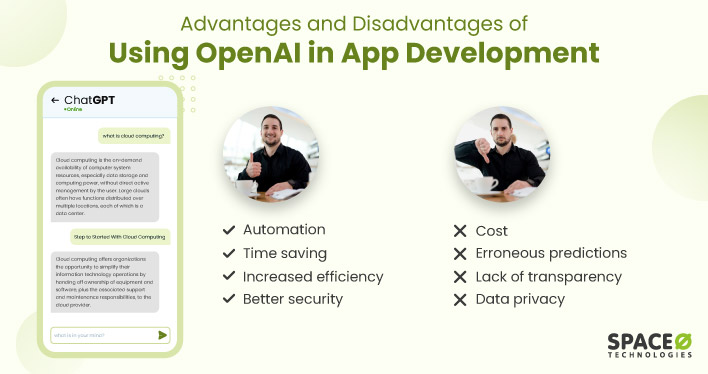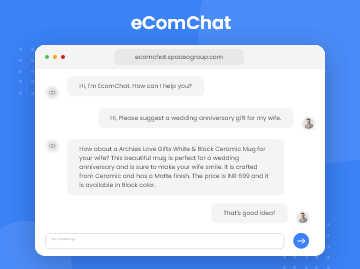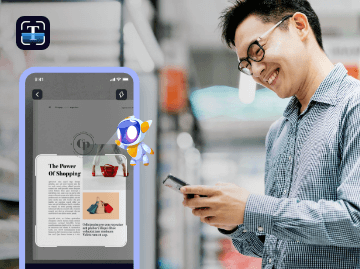With the adoption of AI in the digital age, businesses are shifting towards various AI models to build mobile apps.
One of the most advanced AI platforms available is OpenAI. Many enterprises are looking forward to leveraging the benefits of OpenAI.
However, how will you find out whether OpenAI is the right model for your app development project? We have experience providing AI app development services using OpenAI, so we can help you navigate the decision-making process.
So, in this blog, we will be covering the advantages and disadvantages of using OpenAI in app development.
Before that, let’s first have a look at a few statistics of app development using OpenAI.
Table of Contents
Statistics of App Development Using OpenAI
- According to CBInsights, OpenAI has raised $14B over 10 rounds. OpenAI’s latest funding round was a Secondary Market – III on February 16, 2024. Additionally, OpenAI’s valuation in April 2023 was $27,000 – $29,000M.
- According to a report of Enterprise Apps Today, over 3,000,000 active developers are using DALL-E for training algorithms. This indicates developers are engaging with OpenAI’s technologies, likely including app development projects that incorporate AI features or capabilities provided by OpenAI.
- According to Market Research Report, the Global Generative AI Market size is expected to be worth around USD 255.8 Billion by 2033, from USD 13.5 Billion in 2023, growing at a CAGR of 34.2% during the forecast period from 2024 to 2033.
6 Advantages of Using OpenAI in App Development
Discussing the advantages of using OpenAI will clear your doubts about how efficiently it can help you build your mobile app. You will also learn various ways to leverage OpenAI for app development.
Using OpenAI to Include Predictive Analytics Features for Better App Monetization
Predictive analytics is an interesting feature of OpenAI that enables you to use machine learning techniques for analyzing data and making predictions. Predictive analytics is implemented to improve the performance of AI-based systems, such as chatbots.
Using various algorithms and models, such as linear regression, decision trees, and neural networks, you can perform predictive analysis and know forecasting sales, identify potential customer churn, or detect fraud. The goal of using OpenAI is also to understand your customers so that you focus on personalized marketing and advertising to reduce churn rate.
For example,- In-app Purchase Prediction: By analyzing user behavior, a model could predict which users are most likely to make an in-app purchase, and target them with personalized promotions or offers.
- Ad Targeting: A model could predict which users are most likely to click on ads, and target them with ads that are more likely to be relevant to their interests.
Eventually, this will help you find better app monetization techniques that suit your user base and increase business profit.
Automation of Repetitive Tasks to Streamline Operations
As OpenAI uses various pre-trained models and machine learning algorithms, it becomes easy to automate certain tasks. As a result, OpenAI is highly capable of performing tasks like image recognition, text summarization, and sentiment analysis.
You can use GPT-3, a feature of OpenAI, for natural language processing. This model will help you understand specific language patterns and can be used to automate tasks such as answering customer queries or responding to emails.
For example,- Customer Service: An OpenAI model can be trained to automatically respond to common customer inquiries, freeing up customer service representatives to handle more complex issues.
- Healthcare: An OpenAI model can be used to automate the process of identifying patients who may be at risk of certain conditions, such as chronic diseases, so that they can be prioritized for preventive care.
Moreover, leveraging OpenAI will allow you to auto-generate API documentation, database schema, and custom routes. Another model of OpenAI is robotic process automation (RPA) which allows the automation of repetitive tasks such as data entry, form filling, and other similar tasks.
Increased Speed, Reduced Development Time, Time Saving, & Cost Reduction
As you will be able to automate certain tasks, eventually, you will increase your speed and reduce development time and costs. OpenAI can assist you with automating app testing as well.
With the help of OpenAI, you will be able to generate test cases and test scripts, lowering the app development budget and timeline.
For example,- Natural Language Processing (NLP): OpenAI’s pre-trained models, such as GPT-3, can be fine-tuned for specific NLP tasks such as language translation, text summarization, and sentiment analysis. This can greatly reduce the development time and resources required to train a new model from scratch.
- Image Generation: OpenAI’s DALL-E can be used to generate images from text descriptions, which can be used to improve image search, generate training data for computer vision models, and more. This can save time and resources compared to manual image annotation.
- Optimization Problems: OpenAI’s GPT-3 can be fine-tuned to perform optimization tasks, such as scheduling and routing, which can greatly speed up the optimization process and reduce development time.
Additionally, the functioning and usability of an app can be tested using the machine learning models of OpenAI, which can replicate user interactions with an app.
Increased Efficiency With Fewer Errors
With OpenAI, you will get explanations for error messages and suggestions for fixing them immediately.
For example,- Medical Diagnosis: OpenAI models can be trained on large medical datasets to assist with diagnostic tasks, such as identifying diseases from medical images. This can increase efficiency by providing more accurate and faster diagnoses, and reduce errors caused by human diagnostic errors.
- Quality of Service: OpenAI models can be used to predict customer behavior and anticipate customer needs, which can increase efficiency by reducing response time and increasing customer satisfaction, and reduce errors caused by human inspection errors.
In addition, the machine learning model is also set to analyze the code and identify potential bugs. Leveraging OpenAI will enable the developers to make fewer errors and locate and fix errors more quickly to avoid any unfavorable incidents.
Moreover, it will improve the overall process of code debugging, helping you save time, money, and effort.
Easy to Integrate AI Features Into Apps
You get various tools and services that you can integrate into your app easily.
For example,- OpenAI’s GPT-3 generates text and performs natural language processing tasks to help you in language translation, summarization, and question answering.
- OpenAI’s DALL-E is another tool that you can integrate to generate images and videos from text descriptions.
- OpenAI’s GPT-based models will help you generate code snippets, chatbot responses, and other data types.
You can use APIs in order to integrate these tools into the apps and access their capabilities without building these models from scratch.
- OpenAI’s GPT-3 API: This API allows developers to easily integrate natural language processing (NLP) capabilities into their apps. With GPT-3, apps can generate human-like text, perform language translation, summarization and more.
- OpenAI’s DALL-E API: This API allows developers to easily generate images from text descriptions, which can be used to improve image search, generate training data for computer vision models.
In fact, you will also get libraries and SDKs for popular programming languages such as Python, Java, and JavaScript to make the integration process easier. With the ability to integrate AI features you can find many unique ideas to build apps with OpenAI API.
Better Security in Apps
The machine learning model of OpenAI will help you detect and safeguard applications from security threats, such as malware and unauthorized access. It will help you identify the potential threat and vulnerability in the network traffic that the attackers could exploit.
OpenAI also comes with features like biometric authentication and secure data encryption to safeguard the apps and offer better security. It identifies suspicious behavior and alerts you immediately so that you can take action immediately. It generates secure code snippets and configurations to enhance application security.
Now, we will discuss the cons of using OpenAI to develop an app. Before deciding to get in touch with an app development service provider you also need to know the cons of OpenAI. So, have a look.
Want to Build a Next-gen App Using OpenAI Model?
We have experience developing over 4400 applications for iOS and Android platforms.

Disadvantages of Using OpenAI in App Development
Let’s talk about all the major challenges you will need to face in order to use OpenAI for app development.
Increased Cost
The biggest disadvantage of using OpenAI is the cost, which can be expensive for many users in order to integrate models or update or maintain the applications.
As it requires significant computational resources to run, users will need to pay for this usage, making it more difficult to maintain an app with OpenAI models.
If you are ready to invest in the usage, APIs, and maintaining the app, then you don’t have to consider this challenge while using OpenAI. However, there are other cons as well that you need to look at before making any decisions.
Integration Issues
There are various potential issues when it comes to the integration of OpenAI models.
- Model size and complexity can make it difficult for you to integrate into apps because of resource-constrained devices.
- Latency and responsiveness are other challenges that can occur when making API calls to the models.
- It comes with usage restrictions and licensing agreements while integrating models into the app.
- It requires a lot of maintenance and updates.
- You also don’t have much control over the model once it is integrated. It can limit the ability and specific use cases.
Data Privacy and Security Concerns
OpenAI comes with data privacy and security concerns as it is typically trained on large sets of data. This includes a lot of sensitive information and financial data. Also, while calling APIs, there is a chance of transmitting sensitive data over the internet. Therefore, if not handled properly, there is a high chance of a data breach.
Hence, you need to be aware of such security concerns while using OpenAI models. You can take certain precautionary measures to mitigate them. For example, you can use secure protocols, encrypt data in transit, perform regular security audits, and implement security best practices.
Lack of Transparency
As the models of OpenAI are very complex, it can be challenging for you to understand. With less transparency, you might not be able to know how these models process data and how information is used to make decisions.
Also, being a private company, it may not disclose all details of its technology. Therefore, there will be a lack of interpretability, safety, and privacy concerns.
Possibility of Erroneous Predictions
After all, OpenAI is artificial intelligence, and it certainly can make erroneous predictions. Moreover, as OpenAI is trained on large sets of data, its predictions can be inaccurate and biased.
Additionally, OpenAI is complex and offers a lack of interpretability, increasing the chances of making incorrect predictions. Also, these models are run by humans, so there is a high chance of human error in the process, which can cause the model to make incorrect predictions.
Hence, you will need to be a little alert when it comes to using OpenAI and take immediate action when you get to know the errors.
Also, being a private company, it may not disclose all details of its technology. Therefore, there will be a lack of interpretability, safety, and privacy concerns.
Want to Discuss Your Unique Mobile App Idea?
Talk to us. Our experienced technical consultant will help you validate your app idea and suggest you the best possible ways to use OpenAI in an effective manner.
You can also go through our post on different models of OpenAI in app development for getting a better idea about how OpenAI can be utilized in application development.
After learning about the pros and cons of using OpenAI, if you are still concerned about how OpenAI deals with data privacy and security issues and how it can ultimately enhance the efficiency of the app, then you need to check the next section.
Frequently Asked Questions about Using OpenAI in App Development
How does OpenAI deal with data privacy and security issues?
OpenAI takes various measurements in order to safeguard data and deal with security issues.
- Restricting unwanted access to production systems
- Encryption of sensitive data to protect it
- Conducting regular security audits and penetration testing
- Monitoring and logging system activity to identify security threats immediately
- Complying with all relevant laws and regulations
- Multi-factor verification (MFA) method
Is it possible to use OpenAI to improve the performance and efficiency of existing apps?
Yes, this is possible. This is the reason OpenAI is the best option when it comes to increasing the efficiency of an app. With OpenAI, you get pre-trained models and tools to add the capabilities of an AI (artificial intelligence).
For example, GPT-3 allows you to add natural language processing capabilities to apps. On the other hand, the DALL-E model is used for generating images, videos, and texts.
Ready to Use OpenAI to Enhance Your Mobile App?
Like every other tool, OpenAI has its own share of advantages and disadvantages. Through this guide, you get to know the pros and cons of using OpenAI in app development in-depth. So before you go ahead with making any decision, it is essential for you to consider the cost, technical requirements, and data privacy and security implications.
When it comes to AI-based app development we have developed several applications. Here are some of the AI-powered apps recently developed by our team.
AI-powered Apps Developed by Space-O
In case you face any challenge in understanding more about the role of OpenAI API and how you can actually implement it in your app, then consult our experienced mobile app development team. Our technical consultant will understand your requirements and help you devise a custom roadmap to bring your idea to life.






